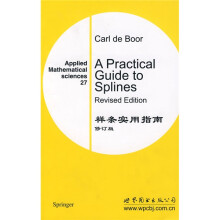Preface
Notation
I Polynomial Interpolation
Polynomial Interpolation:Lagrange form
Polynomial Interpolation:Divided differences and Newton Form
Divided difference table
Example:Osculatory interpolation to the logarithm
Evaluation of the Newton form
Example:COmputing the derivatives of a polynomial in Newton form
Other polynomial forms and conditions
Problems
II Limitations of Polynomial Approximation
Uniform spacing of data can have bad consquences
Chebyshev sites are good
Runge example with Chebyshev sites
Squareroot example
Interpolation at Chebyshev sites is nearly optimal
The distance form polynomials
Problems
III Piecewise Linear Approximation
Broken line interpolation
Borken line interpolation is nearly optimal
Least-squares approximation by broken lines
Good meshes
Problems
IV Piecewise Cubic Interpolation
Piecewise cubic Hermite interpolation
Runge example continued
Piecewise cubic Bessel interpolation
Akimas interpolation
Cubic spline interpolation
Boundary conditions
Problems
V Best Approximation Properties of Complete Cubic Spline Interpolation and Its Error
Problems
VI Parablolic Spline Interpolation
Problems
VII A Representation for Piecewise Polynomial Functions
VIII The Spaces II and the Truncated Power Basis
IX The Representation of PP Functions by B-Splines
X The Stable Evaluation of B-Splines and Sploines
XI The B-Spline Series Control Points and Knot Insertion
XII Local Spline Approximation and the Distance from Splines
XIII Spline Interpolation
XIV Smoothing and Least-Squares APproximation
XV The Numerical Solution of an Ordinary Differential Equation by Collocation
XVI Taut Splines Periodic Splines Cardinal SAplines and the APproximation of Curves
XVII Surface Approximation by Tensor Products
Postscript on Things Not Covered
Appendix:Fortran Programs
Bibliography
INdex

 缺书网
缺书网 扫码进群
扫码进群





